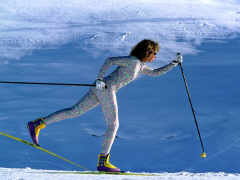|
Equal
Opportunity Coaching
Part 2: Good News, Bad News
As the
women's sports industry has become more profitable than
ever before (though, arguably, it has much further to go),
Williams is among those who have watched women coaches slowly
vanish from high school and college playing fields. Since
1977, retired Brooklyn College professors Vivian Acosta
and Linda Carpenter, both former coaches of various women's
sports, have conducted a yearly study of female participation
in sports and the status of women as collegiate coaches.
Their results for the year 2000 demonstrate two extremes.
"The good news is, there are more and more college-age women
and women at the high school level participating in sports,"
says Carpenter of this year's report, which shows women's
participation in sports at an all-time high. "The bad news
is that the number of women who are coaching and serving
as administrators is the lowest ever in history." When Title
IX was enacted in 1972, women coached more than 90 percent
of women's teams. By the year 2000, that figure fell to
45.6 percent.
Marjorie
Snyder, the program director for the Women's Sports Foundation,
says the sharp decline in numbers of female coaches is one
direct result of how many schools responded to Title IX
- by combining their women's and men's athletic departments.
"If you had the heads of the men's and women's athletic
departments come together," Snyder explains, "invariably
the man became the athletic director, and the woman became
the assistant. It's the athletic director who does the hiring,
and men tend to hire who they know."
Like Williams, Acosta and
Carpenter grew up playing sports pre-Title IX. Their coaches
were primarily women from physical education departments
who volunteered to coach girls because they felt it was
important. Along with the other girls on their "teams,"
Acosta and Carpenter bought their own uniforms and paid
for their travel to away games. Their coaches received thank-you
notes at the end of the year, and not much more.
"Now, the
salaries for coaches are still pretty small," says Carpenter,
"and coaches of women's teams still tend to be paid less
than those of men's teams. But still, the fact that it became
paid had a lot to do with men looking at coaching women
as a viable job."
|

Photo
copyright SuperStock, Inc.
|
"Another
thing is that some [male coaches] started to see [coaching
women] as a stepping-stone to coaching males," says Acosta.
"And, once they started coaching women, found they were
cooperative, they listened, they're eager to please, and
found that they liked coaching girls, sometimes more than
they liked coaching boys."
Coach Rob Donohoe, another graduate of Shore Regional, has
been coaching the Shore's freshman girls' softball team
for the last four years. He says that after years of coaching
the boys' soccer team and boys' basketball teams, he enjoys
coaching girls in the spring.
"Girls are totally different to coach," says Donohoe, 30,
who credits Williams for much of what he knows about coaching
young women. "They are willing to please, but at times they
are harder to manage than boys. I always try to push 'em
to their fullest extent. And sometimes they get pissed at
me. But I definitely enjoy it. Coaching girls and boys,
you get the best of both worlds."
NEXT:
"These are their girlfriends" >>
<<Back
to previous page
|

